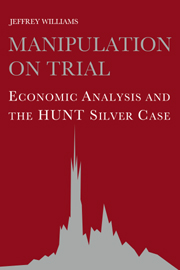Book contents
- Frontmatter
- Contents
- List of figures
- List of tables
- Preface
- Foreword by Thomas O. Gorman
- 1 Why the Hunt silver case?
- 2 Turmoil in the silver market
- 3 Identifying a manipulation
- 4 Testing for the cause of the price rise in silver
- 5 Determining the appropriate price of silver
- 6 Inferring manipulative intent
- 7 The predicament of economic analysis in the courtroom
- Glossary of commodity market terms
- References
- Index
3 - Identifying a manipulation
Published online by Cambridge University Press: 17 September 2009
- Frontmatter
- Contents
- List of figures
- List of tables
- Preface
- Foreword by Thomas O. Gorman
- 1 Why the Hunt silver case?
- 2 Turmoil in the silver market
- 3 Identifying a manipulation
- 4 Testing for the cause of the price rise in silver
- 5 Determining the appropriate price of silver
- 6 Inferring manipulative intent
- 7 The predicament of economic analysis in the courtroom
- Glossary of commodity market terms
- References
- Index
Summary
Because the Hunts protested that they had not manipulated the silver market and because no incriminating documents were found, the economist expert witnesses (and, more fundamentally, the jurors) needed to infer from the Hunts' actions and the circumstantial evidence whether a manipulation had occurred. Presumably, a manipulation of a particular type has an easily identified effect; if that effect is observed (and no other explanation readily found), the evidence of a manipulation having occurred is strengthened. Regarding a classic corner, for example, had the price of bullion for immediate delivery in New York and Chicago vaults soared to $50 per troy ounce while prices for coins, for bullion at other locations, and for the bullion for delivery two years hence remained near $8, such a situation would have provided nearly unassailable circumstantial evidence of the Hunts' liability; had these other prices soared as high as bullion for immediate delivery in exchange-approved vaults, those facts would have provided nearly unassailable evidence of the Hunts' not having cornered the market. Regarding a manipulation of investors' expectations, had a flood of new orders for distant futures contracts followed the Hunts' own trading, with a small spillover into other precious metals markets, that situation would have provided strong evidence of the Hunts' involvement in such a manipulation; had prices and trading volumes in other precious metals markets increased much more than silver, those facts would have provided strong evidence of non-manipulative causes.
Information
- Type
- Chapter
- Information
- Manipulation on TrialEconomic Analysis and the Hunt Silver Case, pp. 64 - 99Publisher: Cambridge University PressPrint publication year: 1995
